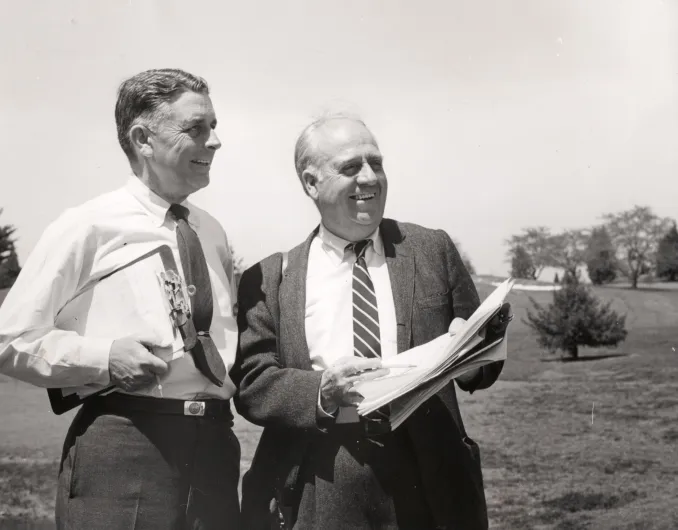NJSGA Hall of Fame Class of 2023 Spotlight: Robert Trent Jones, Sr.

Joseph C. Dey Jr. and Robert Trent Jones at Congressional Country Club, Bethesda, Md, prior to the 1964 U.S. Open Championship. Photo is by Rohland. Copyright Unknown/Courtesy USGA Archives.
KENILWORTH, N.J. – There was a reason he was tabbed the Open Doctor. For Robert Trent Jones, Sr. (1906-2000) he worked tirelessly at his craft of golf course architecture and by the end of his journey, Jones had put together one of the most impressive resumes of any golf course architect.
Jones, who was born in England but immigrated to the United States at three, settled down in Montclair and was enamored by golf course design. He attended Cornell University to study in the field and then in 1948 had his first big break, working alongside Bobby Jones (unrelated) at Peachtree Golf Club in Atlanta.
Part of his legacy as the Open Doctor was due to the fact he had a hand in remodeled so many U.S. Open courses as requeted by Joe Dey, the USGA’s executive director from 1934-1968.
One of his most well-known U.S. Open projects was Oakland Hills Country Club in Michigan.
“He elevated the greens, bunkered the fairways and took a Donald Ross layout and remodeled it in his own style, which was more suited to (Ben) Hogan, who in fact won the tournament there,” said Robert Trent Jones, Jr.
Jones’ work at Oakland Hills had an impact on many prestigious professional golf tournaments, including six U.S. Opens and three PGA Championships.
There was a deliberate method to his work. As a highly skilled player himself, Jones had a better knowledge of where to place obstacles on a golf course. Whether it be bunkers near landing zones or water hazard placement, Jones was intentional with each design.
“In the field is where you learn golf architecture,” said his son, Robert Trent Jones, Jr. “You've got to be a good player to understand the attack and then you have to reverse your mentality to think about it as a defense. That's hard to do if you've played at a competitive level, you’re breaking down the hazards and you're breaking down the holes, especially on strategic golf courses, which is primarily what our family is. We're not penal like the British courses or Pete Dye, we give options to players who think their way through the course, whether it be medal play or match play.”
Jones left his footprint not only in the United States but also worldwide.
“He was the first golf course architect that really went across the world to design golf courses,” Rees Jones commented. “Some had done work around the country, but most golf course architects were local, but because of the advent of the air travel, he was able to expand his talents across the country into Hawaii, Puerto Rico and then Europe and Asia.”
As a matter of fact, Jones is recognized for his work on 310 courses across five continents, 30 countries and 45 states in the U.S.
Jones’ eye and talent as a golf course architect was passed on to his two children, Robert Trent Jones, Jr. and Rees Jones. The two forged their own paths. The oldest established Robert Trent Jones II, Golf Course Architects in California and has had a successful career that’s spanned four decades.
“He taught me to sketch,” Robert Trent Jones, Jr. recalled. “Starting in junior high school, he told me to sketch, not just of golf courses, but to sketch the tree, sketch, whatever you see. You either have that gene or you don't, and then you have to learn how to use it.”
As for Rees, his journey has kept him headquartered in New Jersey, founding the golf course design firm of Rees Jones, Inc., located in his hometown of Montclair in 1974.
“It helps to be the son of a famous golf course architect," said Rees. “He gave me the opportunity to have a great life in this profession by mentoring me when I was younger, even before I even got involved. All our vacations were generally places where he was building a golf course. We didn't have a lot of money post World War II, so we had our vacations where Dad was doing some work and I would walk around the sites and become interested in the whole idea of creating something on the ground and that led to my career also.”
Robert Trent Jones, Sr., has left a legacy on the game not only in New Jersey but across the nation, creating and renovating world class venues.
Over the years, Jones received many honors, most notably being inducted into the World Golf Hall of Fame in 1987.
The 2023 Hall of Fame Class will officially be inducted on May 3, 2023 at Galloping Hill Golf Course. Tickets are available and can be purchased HERE.
All-Time NJSGA Hall of Fame Inductees
The NJSGA Hall of Fame, which launched in 2018, has inducted George A. Crump (2022), David Glenz (2022), Karen Noble (2022), Ed Whitman (2022), “Long” Jim Barnes (2021), Max Marston (2021), Marge Mason (2021), Leighton Calkins (2020), Michael Cestone (2020), Carolyn Cudone (2018), William Y. Dear (2018), Dr. Ralph Engel (2018), Johnny Farrell (2018), Leo Fraser (2019), Vic Ghezzi (2018), Charlotte Glutting (2018), Sherry Herman (2020), Arthur “Red” Hoffman (2018), Robert Housen (2018), Robert “Bobby” Jacobson (2019), Milton “Babe” Lichardus (2019), Nestor J. MacDonald (2018), Joseph McBride (2019), John McDermott (2020), Byron Nelson (2018), Maureen Orcutt (2018), Dorothy Germain Porter (2019), Chet Sanok (2018), John Shippen (2018), Allan Small (2020), Jeff Thomas (2019), Albert Warren Tillinghast (2018), Jerome Travers (2018), Dennis Walters (2019), Charles Whitehead (2018), Craig Wood (2019), and Billy Ziobro (2019).
NJSGA Social Media
For the latest updates and news, visit njgsa.org or follow New Jersey State Golf Association on Facebook, Twitter and Instagram at @NJSGA1900.
